Chair Culture: By comparing traditional Chinese and Western chairs, we explore the cultural differences between China and the West
Introduction:
Some people say that the totem of culture is the Tai Chi diagram , which reflects the curvilinear thinking , so people pay attention to flexibility when dealing with others . The totem of Western culture is the cross , which reflects the linear thinking , so Westerners pay attention to rules when doing things , one is one and two is two. The cultural differences between the East and the West have led to different living habits and aesthetics between the East and the West, and this difference is also reflected in the chairs.
Chairs are a kind of seating that is common in both the East and the West. They are very common and widely used in people's daily lives, so they are very representative. By comparing and studying the differences between Eastern and Western chairs, we can fully demonstrate the manifestation of different cultures in furniture, and give us a more intuitive understanding of the differences between Eastern and Western cultures. Next, this article will specifically analyze the differences between Chinese and Western cultures shown in chairs by comparing the differences in materials , structure, appearance and function between traditional Chinese and Western chairs .
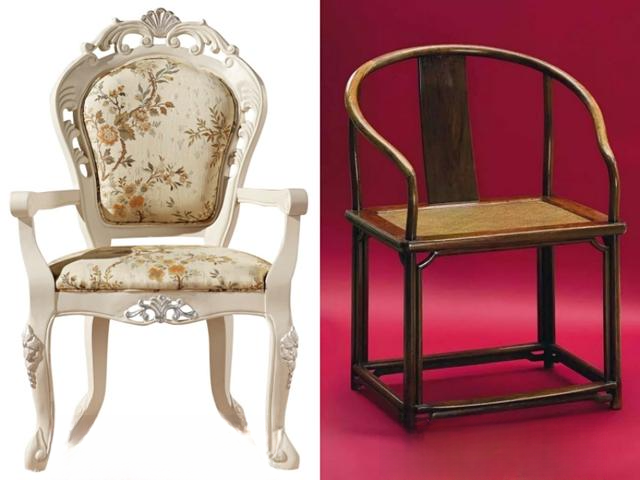
Traditional Chinese and Western chairs with different styles
1. Unity and diversity: Differences in materials between Chinese and Western chairs
1. Wood: the main material for making chairs in ancient times
The traditional chairs in ancient times have always been made of wood . In addition to the fact that wood is easy to process and the chairs made of it are solid and durable, it is also closely related to the ancient architectural culture. In the minds of the ancients, furniture and architecture are an inseparable whole. Architecture is the "outside" and furniture is the "inside". Together, they form a complete living environment. Most ancient buildings are made of wood, so furniture is also made of wood. The integration of the two is in line with the cultural concepts of the ancient people.
Ancient wooden furniture went through a process from lacquer furniture to hardwood furniture , which was also the process of ancient people's understanding, development and innovation of furniture materials. Specifically for chairs, a watershed occurred in the Ming Dynasty : chairs in the Song and Yuan Dynasties were mostly made of softer woods such as camphor, cypress, and fir . Because the material is relatively ordinary, after the chair is made, a layer of paint is generally applied to the surface of the chair by painting, so as to ensure that the chair is more durable. Because the paint covers the wood grain, the chairs of this period lack the texture that wooden furniture should have. After the Ming Dynasty , hardwood chairs began to appear in large numbers. These chairs use dark hardwoods such as huanghuali, red sandalwood, and rosewood , which is what we now call mahogany . With the change of wood, the structure and production process of chairs have also changed since the Ming Dynasty, forming the unique style of Ming and Qing chairs.
The change of chair wood is closely related to the development of traditional culture. The literati and scholars in the Ming Dynasty preferred chairs made of huanghuali, which has an orange color with flashes, bright and beautiful brown eyes. The craftsmen at that time used this characteristic of huanghuali to give the chairs pure and simple, concise and bright, and smooth lines. This injected a mellow literati temperament into the chairs made of huanghuali, which was very in line with the needs of the literati in the Ming Dynasty. This high-quality hardwood furniture reflects the cultural background of the society at that time and has left a strong mark in the history of material civilization.
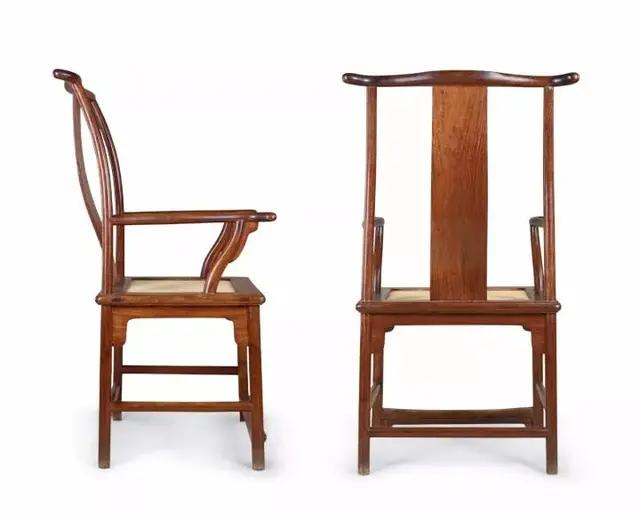
Chair made of Huanghuali wood from the Ming Dynasty
2. From wood to diversity: the evolution of Western chair materials
In the ancient West, since the ancient Egyptians invented chairs, the material used to make chairs has been mainly wood for a long time. The most popular wood in Western Europe is oak, followed by walnut, and cork is the main wood in Central Europe . Since the use of wood in the history of furniture in ancient England is very fixed, the changes are also relatively regular and very representative. Therefore, we will take the materials used to make chairs in England as an example to analyze the changes in chair materials.
Hake Maggot, a researcher of English furniture history, divides the 300-year history of ancient English furniture into the Oak Age, the Walnut Age, the Mahogany Age and the Basswood Age. Similar to ancient times, although the materials of furniture were constantly changing during this period, they did not deviate from the category of wood. However, after the Industrial Revolution, the history of England using wood to make chairs came to an end. In the early 19th century, the iron smelting industry developed rapidly, and the casting level had been greatly improved. The various parts of the chair could be cast using molds and then connected with cranks and screws. This method of rapidly mass-producing chairs quickly replaced traditional wooden chairs and was promoted in the market. After that, England continued to improve iron chairs and formed a unique style.
For example, the Corbroccoli Deller Iron Products Company in the west of England produced a large number of chairs for living rooms and gardens. They applied various beautiful patterns from nature to wrought iron chairs , such as seaweed patterns, grass leaf patterns, rose patterns, etc. These chairs with beautiful patterns and exquisite forging craftsmanship quickly became popular in the market. Later, Breuer invented the steel tube chair , opening a new chapter in English chair design. These steel tube chairs made full use of the characteristics of the material, with a simple structure and a light and elegant shape, becoming a model of design in that era.
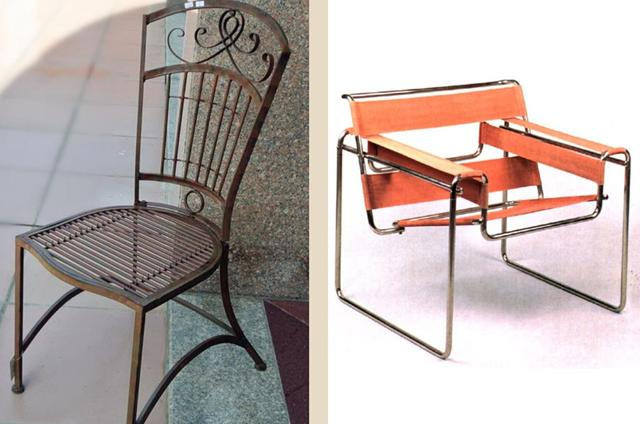
Iron chairs and steel pipe chairs
After World War II , with the discovery of a large number of new materials, the materials used to make chairs in the West became more diversified . New materials such as steel pipes, galvanized steel, stainless steel, nylon, foam, and plastic were used in an endless stream, making Western chairs lighter and more flexible. The most representative of these is the Panton chair designed by Danish designer Panton . This chair uses fiberglass material and an integral molding process. The entire chair is molded in one go, with a very unique appearance and bright colors, giving people a strong sense of sculpture.
The history of materials used to make chairs in ancient times is also a history of the use of wood. Of course, there are bamboo chairs and rattan chairs, but the materials used for chairs in ancient times are still single. People prefer naturally occurring materials when choosing materials, which reflects the humanistic style of the society at that time that advocated nature, purity and simplicity. In contrast, the West uses a variety of materials. With the development of science and technology, they prefer artificial materials, which are easy to mass produce and can bring greater benefits to capitalists, reflecting the humanistic thought of the Western society at that time that puts interests first. Modern fabric sofas, leather sofas, and plastic chairs were also first created in the West. Until now, the diversity and singleness of materials are still important reference indicators for distinguishing Western design from Chinese design.
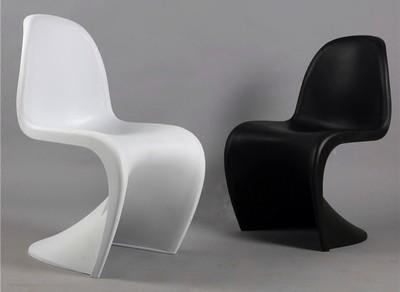
The modern Panton chair
2. Inheritance and Variety: Differences in the Structure of Chinese and Western Chairs
The structure of a chair is divided into internal structure and external structure : the internal structure refers to the way the parts of the chair are connected, which depends on the changes in materials and the development of technology. The external structure is in direct contact with the user, and it is a direct response to the appearance, so it must be suitable for the user. For example, the height and depth of the seat, the tilt angle of the backrest, etc. If these structures are just right, they can eliminate people's fatigue, otherwise they will make the user uncomfortable.
1. The same chair structure
In the thousands of years of historical development, ancient furniture and architecture have always maintained a high degree of consistency, especially chairs, many of whose internal structures are derived from architecture. Since the Song Dynasty , the structure of chairs has been highly consistent with the beam and column wooden frame structure of buildings , and various mortise and tenon structures have been used to combine them into entities, so that the strength and firmness of the chairs are guaranteed. The biggest feature of the early form of the Song Dynasty's straight-back chair is that it is thick and heavy. Its seat and chair feet , crossbeams , backrests and other parts are connected in the form of tenons. At this time, the seat is generally shorter, giving people a simple and honest feeling. By the late Northern Song Dynasty, this kind of straight-back chair had become relatively tall, and some chairs had linings added between the seat and legs, and the manufacturing process had made significant progress.
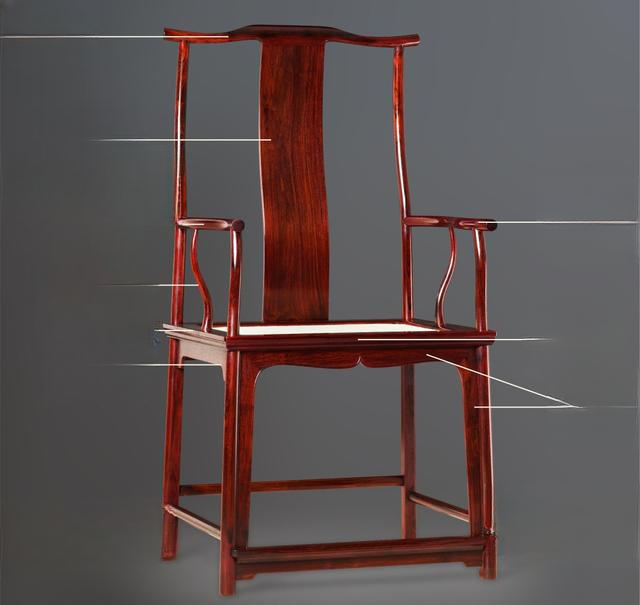
The structure of the brain back chair
In the Ming Dynasty , although the material changed from softwood to hardwood, it did not have much impact on the structure of the chair. The Ming Dynasty chairs basically inherited the structural characteristics of the Song Dynasty chairs. Because of the use of hardwood materials, the Ming Dynasty chairs looked more delicate than the Song Dynasty, but in fact they were more solid. During this period, the biggest change in chair manufacturing technology was reflected in its decorative structure. Regarding the decoration of the chair, we can analyze it from the following two aspects: The first aspect is the structural characteristics of the chair. The external structure of the Ming Dynasty chair is well-proportioned and the size is coordinated and moderate, giving people a harmonious and elegant visual beauty. The second aspect is the decorativeness of the chair structural components, such as the crossbar connecting the two legs of the chair, and the arches inlaid between the legs of the chair that act as crossbars and pillars. These components not only play the role of beautification and decoration, but also play the role of supporting the structure and improving firmness.
In short, the structure of ancient chairs has not changed much in the process of development over the years. This reflects the ancient people's respect for tradition and emphasis on inheritance. Ancient craftsmen constantly innovated in the study of traditional structures, thus developing the simple and beautiful traditional wooden chairs of the Ming and Qing Dynasties.
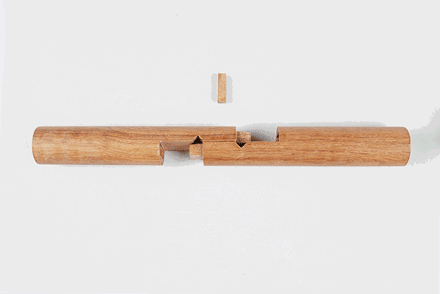
Mortise and tenon structure
2. The structure of Western chairs varies
The structure of Western chairs has been very advanced since ancient Egypt . In addition to the mortise and tenon structure similar to the traditional structure, they also have their own unique overlap structure and wood nail plus metal structure . In the Gothic chair period, designers were inspired by boxes with lids and inlaid thin plates into the frame to form a frame panel structure , opening a new chapter in frame furniture.
During the Renaissance , society began to use secular scientific spirit to resist Christian asceticism and vigorously advocated humanism. This social trend was also reflected in chairs. Chairs at this time absorbed the characteristics of furniture from ancient Greece, Rome and ancient times on the basis of Gothic chairs. The structure changed the fully enclosed frame structure of the legs of medieval European chairs. The lower seat of the chair was completely open, eliminating the dull feeling of the original Gothic chair. In the following period, although the internal structure of Western chairs changed little, the appearance of the seat, backrest, armrests and legs of the chairs changed significantly.
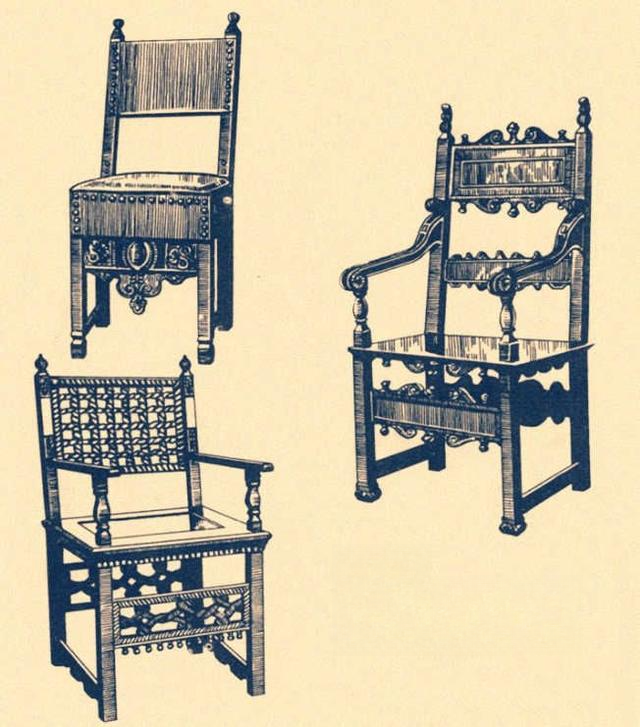
Western Renaissance Chair
In the 19th century, with the rapid development of science and technology, more and more novel structures of Western chairs appeared, such as detachable chair structures and foldable chair structures. The most distinctive one among them is the Tulip Chair , which consists of three parts: first, the aluminum alloy base. Second, the upper main seat made of one-time molded fiberglass plastic. Third, the foam cushion with fabric. The biggest feature of the Tulip Chair is that it breaks through the traditional structure of four legs of the chair, making the chair present a unique shape.
The continuity of chair structure and the variety of Western chair structure show completely different humanistic thoughts. Generally speaking, the ancient chairs imitated the structure of ancient buildings from the beginning. The connection method maintained the mortise and tenon method, which was firm and concealed. The various parts of the chair were integrated, and they complemented the other furnishings in the house and the entire building, reflecting the ideas of harmony and moderation. However, the structure of Western chairs has been constantly changing with the development of new materials and science and technology. At the same time, designers are also happy to explore new structures, showing the Western people's love to pursue new things and the enterprising spirit of active exploration.
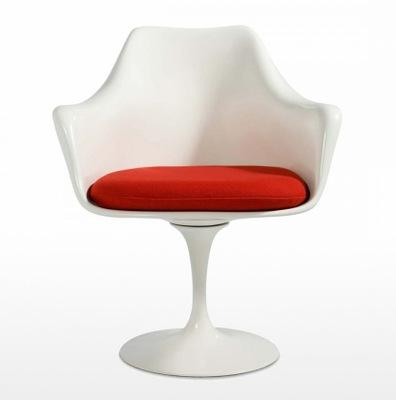
Tulip chair with a modern feel
3. Lines and Shapes: Differences in the Appearance of Chinese and Western Chairs
1. Linearity: the appearance of ancient chairs
In the national art of China, whether it is sculpture, painting or calligraphy, they are all expressed in the form of "line" . "Line" can flexibly and accurately grasp the characteristics of the image of an object. On the one hand, the craftsmen increase the sense of space and three-dimensionality of the chair by using linear design and processing in various parts of the chair. On the other hand , these lines are integrated into the body structure of the chair shape to make the whole object look clear and smooth. The chairs made in this way have the form of "line" everywhere in terms of shape, and the ever-changing lines will bring different aesthetic tastes to people.
For example, the chairs of the Ming Dynasty have a variety of linear components, but generally maintain a simple and appropriate style, showing a concise, smooth and graceful style. And the shape takes into account the human body shape, making it comfortable in proportion and curvature. For example, the Ming-style round chair has a C-shaped curve. This seemingly simple curve contains a scientific proportional relationship. The radius of the chair circle and the radius of the end elbow are exactly 2:1. These two arcs form a beautiful chair circle curve in the form of external cutting. Although its seat surface is just a simple rectangle, the length and width of the seat surface also conform to the golden ratio.
Generally speaking, traditional chairs usually use lines to express the structure, shape, sense of movement, sense of mass and spatial boundaries of the chair. The rhythm and rhythm of the chair's appearance are fully displayed through the virtuality and reality, density, thickness, length, opening and closing, and ups and downs of the lines.
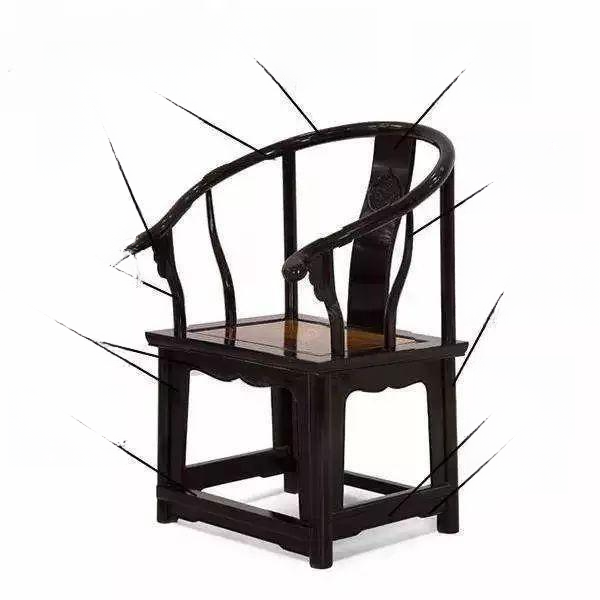
Ming style armchair
2. Shape: the appearance of ancient Western chairs
If ancient chairs focused on the use of lines in terms of appearance , then ancient Western chairs paid more attention to the use of face and body shapes . Since the appearance of chairs in ancient Egypt, Western chairs have continued to have a huge and magnificent sense of volume. For example, the tall and straight Gothic chairs, from various pediments to ever-changing capital decorations, are all inheritances of this magnificent sense of volume.
By comparing with traditional chairs, we can understand the "body shape" characteristics of Western classical chairs very well: First , in traditional craftsmanship, chairs focus on the use of curves, which are characterized by changeability, smoothness, softness and lightness, and have the soft beauty of women. Western chairs focus on the use of straight lines, which are characterized by tranquility, tenacity, hardness and stability, and have the masculine beauty of men. Second, the styles of ancient chairs are mostly simple and simple, with only simple decorations. However, the decoration of Western classical chairs is usually large-scale, and sometimes the entire front of the chair is covered with rich decorative shapes. The repeated emphasis of straight lines will give people a sense of face, and the repeated emphasis of faces will give people a sense of body, which increases the sense of volume of the chair. Third, Western classical chairs do not focus on the combination of virtual and real like Chinese chairs. There are rarely hollow shapes such as openwork and lattice work in chairs. The backrest and armrests are mainly solid, and even some chair legs use a fully enclosed frame panel structure, which gives people a very closed feeling.
If the use of materials in ancient chairs was influenced by ancient architecture, then the appearance of Western chairs was more influenced by Western architecture, so some people say that Gothic chairs are miniature Gothic buildings. The ancients liked to use lines, especially curves, as the main elements of chair shape, while Western modeling elements pay more attention to volume. Lines and body shape, this is the biggest difference in appearance between Chinese and Western classical chairs.
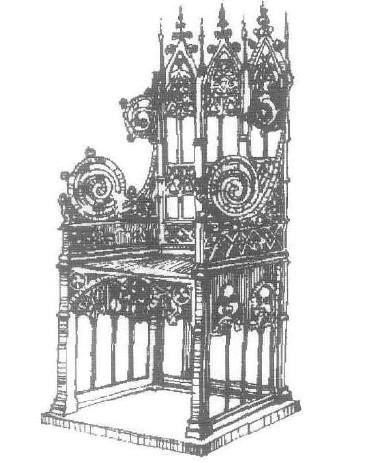
Gothic Chair
4. Pursuing spiritual realm and advocating material enjoyment - Comparison of the functions of Chinese and Western chairs
1. Ancient chairs that pursue spiritual realm
In fact, ergonomics has been applied to production practice in ancient times. Although it has not formed a systematic theory like the West, craftsmen know how to make comfortable chairs. For example, craftsmen in the Ming Dynasty designed a back tilt angle of about 100 degrees for the chair back according to the S-shaped curve formed by the side of the human spine under natural conditions and the necessary tilt angle when people rest. In this way, when people sit on the chair, the ligaments and muscles can get enough rest, thus creating a sense of comfort.
Although ancient craftsmen knew how to make chairs more comfortable, craftsmen in the Tang, Song and Qing dynasties still made the backrests vertical. In this case, people could only raise their heads and chests and sit upright. From this point of view, the ancients seemed to think that the beauty of sitting upright was more important than comfort. Although the Ming Dynasty changed the vertical backrest to an inclined backrest, compared with the comfort brought by this improvement, the main reason why Ming Dynasty chairs were respected was the softness on the outside and the strength on the inside and the simple and dignified literati temperament it contained. In this sense, the spiritual connotation of traditional chairs exceeds the material connotation, reflecting that the ancient people paid attention to behavior and advocated steady, dignified and gentle character. The pursuit of spiritual realm by ancient literati far outweighed the enjoyment of material level. Perhaps this is also the reason why the Hu bed and cross chair that focus on comfort appeared very early but were not widely circulated and popularized.
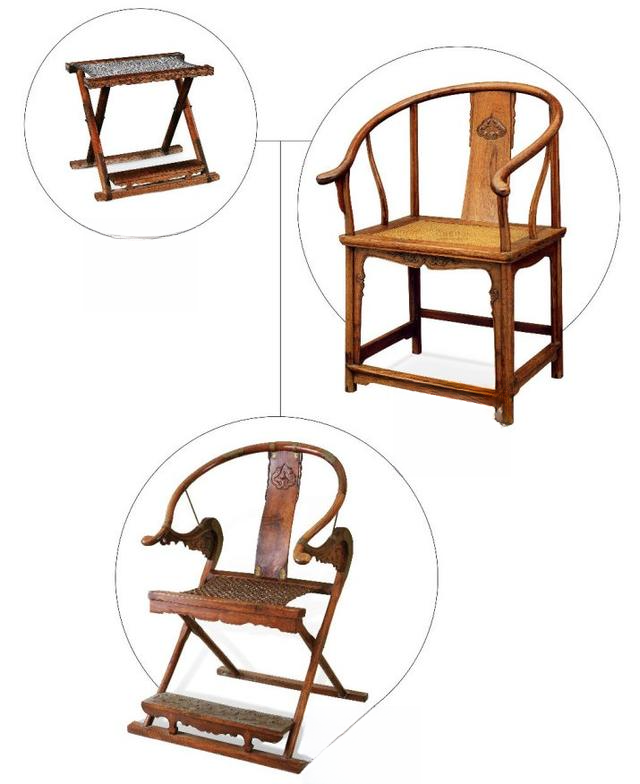
Huchuang, cross-legged chair and round chair
2. Western traditional chairs that pursue material enjoyment
As early as the ancient Greek period , Westerners began to explore the comfort of sitting. In the Renaissance , in order to improve the comfort of chairs, people slightly concave the seat surface into a curved surface, or wrap it with elastic materials. For example, Italian velvet , French silk fabrics , Spanish leather , etc. Adding these materials to the seat surface of the chair is not only comfortable, but also has a good decorative effect. During this period, upholsterers who cooperated with furniture craftsmen appeared in Western society , specializing in the wrapping of elastic materials on furniture, which shows the pursuit of comfort by Westerners. In the Baroque period , not only the seat surface, but also the backrest and armrests were made into a soft structure integrated with the seat surface, which is commonly known as an easy chair.
The sofa is the representative of the "sitting" culture in the West, which fully reflects the Western concept of pursuing enjoyment. The larger tilt angle and softer soft material make the sofa appear more casual, free and relaxing. Especially after the birth of modern ergonomics , designers use a series of methods to test the comfort of human sitting posture in order to design more comfortable seats.
The difference in the perception of chair functions has led to a great difference in the functional design of chairs in ancient and Western times. In general, although classical chairs are not as comfortable as Western ones, they have an emotional interaction with people, making people feel friendly and attractive, reflecting the pursuit of spiritual level. Westerners pay more attention to the comfort, convenience and flexibility of chairs, but lack humanity and emotion in connotation. This situation has largely caused the difference in chair design between China and the West.
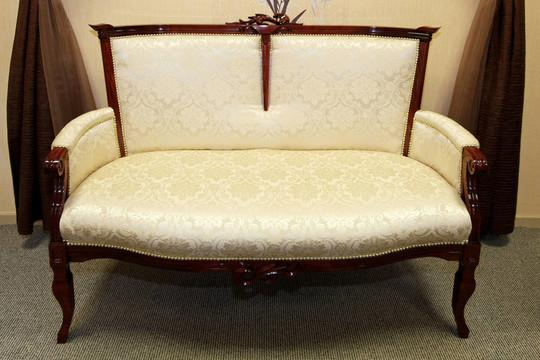
The representative of Western "sitting" culture - sofa
Conclusion
Traditional chairs have always been made of natural materials such as wood, bamboo, and rattan, using mortise and tenon joints. They have structural characteristics that are consistent with ancient buildings, and use a variety of graceful and soft curves as the main modeling elements, showing the profound connotation of Chinese traditional culture.
Unlike traditional chairs, Western classical chairs use a variety of materials and structures. The overall shape has a heavy sense of volume, and the function pays more attention to comfort, reflecting the spirit of exploration and pragmatism in Western social culture.
The development of chairs reflects the brilliance of culture. The development history of chairs in China and the West is two relatively independent systems. In their development process, they fully demonstrate the characteristics of their respective cultures. By comparing the differences between the two, we can have a new understanding of the differences between Eastern and Western cultures, which has important implications for us to inherit traditional culture and learn from Western ideas.
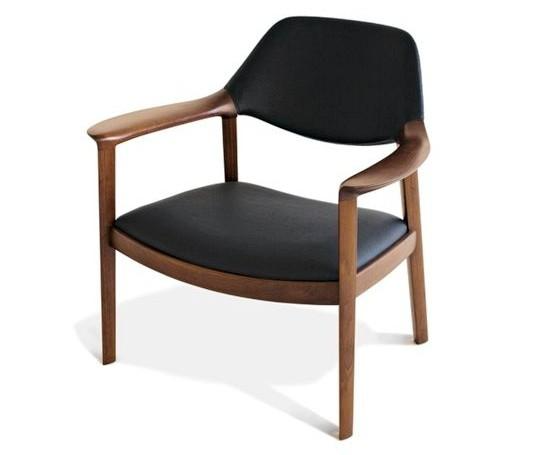
Chair design combining Chinese and Western styles
(End of full text)